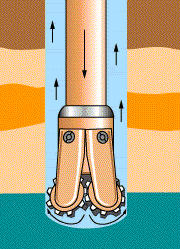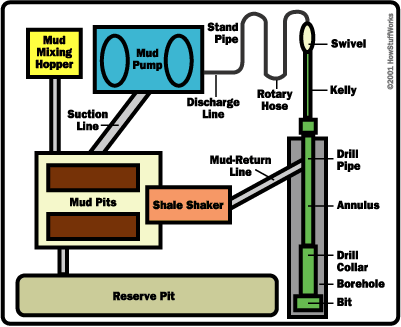| |
Preparing to Drill
Once the site has been selected, it must be surveyed to
determine its boundaries, and environmental impact
studies may be done. Lease agreements, titles and right-of
way accesses for the land must be obtained and evaluated
legally. For off-shore sites, legal jurisdiction must be
determined.
Once the legal issues have been settled, the crew goes
about preparing the land:
- The land is cleared and leveled, and access roads
may be built.
- Because water is used in drilling, there must be
a source of water nearby. If there is no natural
source, they drill a water well.
- They dig a reserve pit, which is used to dispose
of rock cuttings and drilling mud during the
drilling process, and line it with plastic to
protect the environment. If the site is an
ecologically sensitive area, such as a marsh or
wilderness, then the cuttings and mud must be
disposed offsite -- trucked away instead of
placed in a pit.
Once the land has been prepared, several holes must be
dug to make way for the rig and the main hole. A
rectangular pit, called a cellar, is dug around
the location of the actual drilling hole. The cellar
provides a work space around the hole, for the workers
and drilling accessories. The crew then begins drilling
the main hole, often with a small drill truck rather than
the main rig. The first part of the hole is larger and
shallower than the main portion, and is lined with a
large-diameter conductor pipe. Additional holes
are dug off to the side to temporarily store equipment --
when these holes are finished, the rig equipment can be
brought in and set up.
Setting Up the Rig
Depending upon the remoteness of the drill site and its
access, equipment may be transported to the site by
truck, helicopter or barge. Some rigs are built on ships
or barges for work on inland water where there is no
foundation to support a rig (as in marshes or lakes).
Once the equipment is at the site, the rig is set up.
Here are the major systems of a land oil rig:

Anatomy of an oil rig
Power system
- large diesel engines - burn diesel-fuel
oil to provide the main source of power
- electrical generators - powered by
the diesel engines to provide electrical
power
Mechanical system - driven by electric
motors
- hoisting system - used for lifting
heavy loads; consists of a mechanical
winch (drawworks) with a large
steel cable spool, a block-and-tackle
pulley and a receiving storage reel for
the cable
- turntable - part of the drilling
apparatus
Rotating equipment - used for rotary
drilling
- swivel - large handle that holds
the weight of the drill string; allows
the string to rotate and makes a pressure-tight
seal on the hole
- kelly - four- or six-sided pipe
that transfers rotary motion to the
turntable and drill string
- turntable or rotary table -
drives the rotating motion using power
from electric motors
- drill string - consists of drill
pipe (connected sections of about 30
ft / 10 m) and drill collars (larger
diameter, heavier pipe that fits around
the drill pipe and places weight on the
drill bit)
- drill bit(s) - end of the drill
that actually cuts up the rock; comes in
many shapes and materials (tungsten
carbide steel, diamond) that are
specialized for various drilling tasks
and rock formations
Casing - large-diameter concrete pipe that
lines the drill hole, prevents the hole from
collapsing, and allows drilling mud to circulate
|
Circulation system - pumps drilling
mud (mixture of water, clay,
weighting material and chemicals, used to
lift rock cuttings from the drill bit to
the surface) under pressure through the
kelly, rotary table, drill pipes and
drill collars
pump - sucks mud from
the mud pits and pumps it to the
drilling apparatus
pipes and hoses -
connects pump to drilling
apparatus
mud-return line -
returns mud from hole
shale shaker - shaker/sieve
that separates rock cuttings from
the mud
shale slide - conveys
cuttings to the reserve pit
reserve pit - collects
rock cuttings separated from the
mud
mud pits - where
drilling mud is mixed and
recycled
mud-mixing hopper -
where new mud is mixed and then
sent to the mud pits
|

Photo courtesy
Institute of Petroleum
Mud circulation in the hole
|

Drill-mud circulation
system
- Derrick - support structure that holds the
drilling apparatus; tall enough to allow new
sections of drill pipe to be added to the
drilling apparatus as drilling progresses
- Blowout preventer - high-pressure valves (located
under the land rig or on the sea floor) that seal
the high-pressure drill lines and relieve
pressure when necessary to prevent a blowout (uncontrolled
gush of gas or oil to the surface, often
associated with fire)
back
|
|
![]()
![]()